I Grew Up Visiting Taiwan — but Only Recently Explored Its Mountains, Beaches, and National Parks
Beyond the city limits of ultramodern Taipei lies a wild and majestic landscape. Here's how to plan an adventurous trip through Taiwan.

Sean Marc Lee
Visitors at a fumarole at Yangmingshan National Park.A mountain embodies a certain notion of the absolute: the enormity of natural terrain and the deep time it took to shape it, condensed into one hulking totality. But as I climbed what felt like my millionth flight of stairs toward the peak of Qixing Mountain, in Taiwan’s Yangmingshan National Park, I was reminded that a mountain can also be relative. I had climbed many mountains above the 10,000-foot mark in my home state of Colorado, but had never been so intimidated as I was by this 3,675-footer. Technically a dormant volcano, it seemed to rise straight up from sea level, stretching toward the constellation that gave it its name: Qixing means “Seven Stars,” the Chinese name for the Big Dipper.
Here on the path to the summit, as I hiked alongside my husband, Alex, thickets of tall tufted grass were busy with small, bright birds and the occasional plump, clumsy one scratching at the leafy floor in search of insects. Our guide, Vincent Hsu, a nature photographer with a passion for long backpacking trips, said that this was a “bumble chicken,” more formally known as a Taiwan partridge. We had already passed through a slideshow of strikingly varied terrain: billowing fumaroles from which sulphurous steam spilled into the sky like in some Venusian desert; serene lily ponds that emitted a thick curtain of frog song. But nothing had prepared us for the sheer verticality of this landscape. Alex observed that the stone steps seemed to extend straight into the clouds at a 90-degree angle, almost as if this were not a real place but some extremely convincing trompe l’oeil painting.
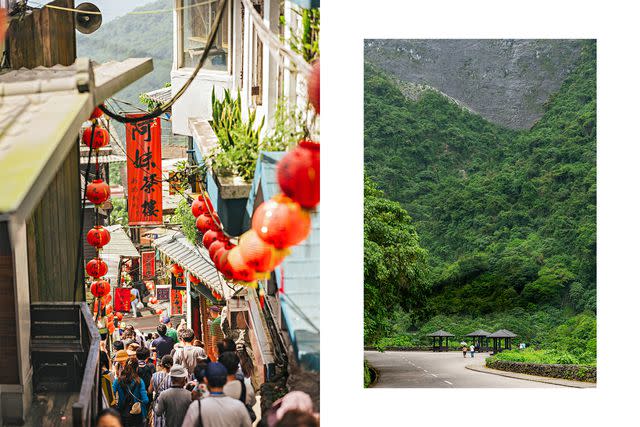
Sean Marc Lee
From left: The famous red lanterns of Old Street, in the Taiwanese mountain town of Jiufen; the steep coastal cliffs of Qingshui.Taiwan, an island roughly the size of the Netherlands with a population comparable to that of Australia, is less known for natural settings than for its modern exports: bubble tea studded with chewy balls of tapioca and the high-powered microchips that power every new iPad, iPhone, and MacBook. My Taiwanese mother emigrated to the United States shortly before my birth, and I grew up visiting Taipei every few years. On these trips, we ate meals with family friends and wandered the city’s numerous night markets, where vendors hawked everything from fried squid to linen pants. My experience of Taiwan was almost entirely bounded by the circumference of the city, where a visitor can zip from a mind-blowing noodle soup eaten on a flimsy plastic stool to a state-of-the-art karaoke lounge.
But for all its civilized comforts, Taiwan is also a place with a surprising array of habitats — from frigid mountaintops to lush subtropical and tropical forests — all accessible by high-speed rail or the occasional hour-long stint on a plane. Its 23 million inhabitants live mostly in efficient urban clusters, partly because of the steep, landslide-prone topography, and venture out to the periphery for day trips or weekend getaways. As Hsu told us, it’s commonly said that to truly be Taiwanese, you have to complete three tasks: climb Jade Mountain, the highest peak on the island at nearly 13,000 feet; swim the nearly 10-mile length of Sun Moon Lake; and bicycle the island’s 621-mile circumference. Hsu had recently checked off all three.
"Taiwan, an island roughly the size of the Netherlands with a population comparable to that of Australia, is less known for natural settings than for its modern exports: bubble tea studded with chewy balls of tapioca and the high-powered microchips that power every new iPad, iPhone, and MacBook. But for all its civilized comforts, Taiwan is also a place with a surprising array of habitats— from frigid mountaintops to lush subtropical and tropical forests."
As we climbed, he explained that these slopes were the consequence of Taiwan’s relative “newness” as an island. The land we stood on was formed just 4 to 5 million years ago, from vigorous volcanic activity at the intersection of two tectonic plates that forced the earth upward into the shapes that surrounded us. The process created a network of hot springs all over the island, where today people go to dissolve their stress in geothermal heat. I could see that the ridges of the mountain range had a sharpness to them: they had not been softened by erosion. The green walls were thick with moss, flowers, and ferns. “Has anyone ever fallen off the mountain?” I asked Hsu as I looked behind us. He smiled encouragingly, told us that even the elderly climb this peak with no trouble, and offered us some water from his pack.

Sean Marc Lee
From left: Qingshui Cliff, which overlooks the Pacific Ocean; the Long Gone Café, at Qixingtan beach.The ascent was daunting, but at the top we were rewarded by a view of the Tamsui River, shining silver as it threaded its way through Taipei, and by a cool breeze that made the grasses around us rustle. Clouds pooled around the mountaintops, making it look as though they were islands in an ocean of soft white; this was called “cloud sea,” Hsu told us. Through the slight veil of cloud cover, the landscape had a minimalist elegance, like a poem or an ink painting. And as we headed down, the way back as easy as the way up was strenuous, I marveled at how it was possible for this lush and rugged place to exist only 40 minutes from the center of the city.
To be fair, there’s plenty that’s wild and green even in the heart of Taipei, a much-Instagrammed city of 2.6 million that nevertheless evokes a sense of intimacy with its peaceful side streets, community gardens, and cozy coffee shops. Just steps from the din of mopeds and high-fashion shopping areas, I found myself wandering among artisanal teahouses and shops selling handcrafted furniture, watching egrets fish from picturesque canals, and feeling as though I had stepped back in time. The streets are lined with banyan trees shaggy with aerial roots that drape all the way to the ground, and flowers and vines overflow from rainspouts and planters, flourishing in the island’s subtropical climate.

Sean Marc Lee
From left: The lobby tearoom at the Liiko Hotel; rice noodle soup with squid for breakfast at the Gloria Manor hotel, in Kenting.Related: Taiwan Introduces Plan to Attract Tourists — by Paying Them
The day before the hike, Hsu had taken me to the top of Taipei 101, the 101-story tower that serves as a centerpiece of the city as well as the home of its most upscale stores. As we took in the panoramic views from the observation deck, he pointed out the different peaks and waterways that define the cityscape. “The city runs like a river between the mountains,” he explained.
We took the high-speed elevator back down to the ground floor, where we stopped for lunch at the flagship of Din Tai Fung, a world-famous chain specializing in xiaolongbao, soup dumplings traditionally filled with broth and juicy pork. A delicate purse of dough with 18 intricate folds — the restaurant’s signature — each one looked a little like some fabulous flower sitting in the trough of a porcelain spoon. Afterward, we headed to the historic shopping area of Dadaocheng for ripe strawberries hand-wrapped in red bean paste and soft, fresh mochi from a street-side stand, which we ate while strolling past old-fashioned shops selling dried fruit, herbal medicine, and oolong tea. We ended up on the banks of the Tamsui River, alongside stalls selling Junmai sake and bubble waffles, watching Taiwan blue magpies with long, parrot-like tails dart between the trees.
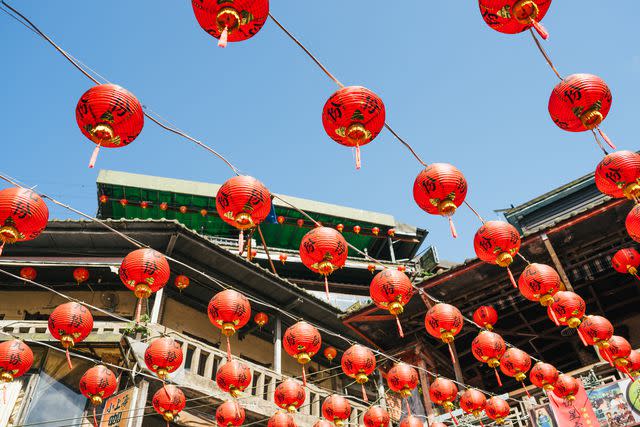
Sean Marc Lee
Lanterns in front of the Shengping Theater, in the town of Jiufen.After our exhausting hike up Qixing, all I could manage at dinnertime was a siesta on the lushly landscaped roof garden of the Mandarin Oriental, Taipei — an impeccably appointed hotel that makes a strong argument for service in Asia being the best in the world. (While Alex and I were out, a bookmark appeared in the open paperback I had left on the nightstand.) As dusk began to fall, I emerged from the Murano-glass-tiled pool and an attendant immediately handed me a towel and a cup of warm ginger tea, which I sipped beneath the cover of tropical plants and palm trees, very tired and very full.
As it turned out, eating outdoors may well be Taiwan’s national pastime: the following day, Alex and I went to the mountain town of Jiufen, which looks to many people like the inspiration for Hayao Miyazaki’s classic animated film Spirited Away. On a twisty old street lined with red paper lanterns, we devoured sweet taro and mung bean soup, palm-size “wheelcakes” cooked in a metal mold and filled with silky vanilla custard, and a sort of rice-paper burrito filled with taro ice cream, crushed peanut brittle, and cilantro that was shockingly delicious. We spent the night at the Gaia Hotel in Beitou, the hot-springs district of Taipei, where we steeped our tired muscles in the mineral baths amid the nighttime sounds of a picturesque garden.
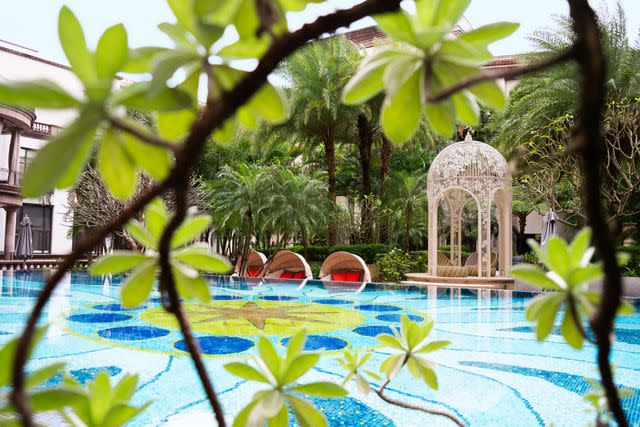
Sean Marc Lee
The pool at the Mandarin Oriental, Taipei.The first Western sighting of Taiwan was in 1544, when Portuguese sailors on their way to Japan named it Ilha Formosa — “beautiful island.” The Spanish arrived in the 17th century, followed by the Dutch, who operated a branch of the East India Company on the island’s western flank until they were forced out by the Ming general Koxinga and by the Indigenous Wu-lao-wan tribe, which defended its territory fiercely. Subsequent waves of migration — the largely Fujianese Chinese who came during the Qing dynasty in the 18th and 19th centuries, the Japanese colonists who occupied the land from the beginning of the 20th century until the end of World War II, the nationalist Chinese who fled Mao Zedong’s regime and renamed the island the Republic of China — have given Taiwan a multifaceted culture that reflects its complex history.
"The Taiwan that would-be colonizers encountered was often described as an impassable wilderness, inhabited by Indigenous tribes who fished in the flatter lands to the south or hunted deer in the challenging terrain of the central mountains."
Today, Taiwan is perched uneasily between the “One China” narrative advanced by Beijing, which claims that the island is part of its territory, and a sort of ad hoc independence. Taiwan is self-governing and democratic, but only a handful of nations recognize it as a sovereign state. Pro-independence sentiment is on the rise, and though Mandarin is now the primary language, almost 80 percent of the population speaks Taiwanese. Traces of the Japanese, Dutch, and even Spanish presence can be found in the names of places — like the cape of Yehliu, which comes from the Spanish “Punto Diablo” — and in distinctively Taiwanese takes on other cuisines, like sushi rolls filled with dried pork floss.
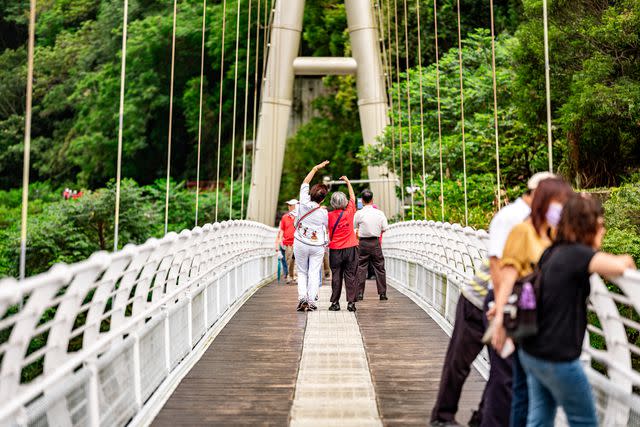
Sean Marc Lee
The Taroko Gorge Buluowan suspension bridge.The Taiwan that would-be colonizers encountered was often described as an impassable wilderness, inhabited by Indigenous tribes who fished in the flatter lands to the south or hunted deer in the challenging terrain of the central mountains. One Qing-era critic, writing to dissuade the government from annexing this untamed, unmapped place, called the island a “ball of mud beyond the seas,” a place of boars, leopards, and rats.
The Japanese painter Ishikawa Kinichiro, who was part of the wave of artists and scholars that arrived following Japan’s military takeover, was moved by the “powerful contours” of the mountains and the richness of the island’s colors. “According to legend,” he wrote, “the place is hell, but once one sees it, it becomes heaven.” Taiwan was steeper, greener, more brutally majestic than the landscapes visitors were familiar with, and glimpsing it roused feelings of awe not so different from the transcendent experience of the sublime that newcomers encountered on seeing the cliffs and canyons of the American West.
Related: How One Brand Is Preserving and Promoting Indigenous Taiwanese Craft
One such site of startling majesty is Taroko Gorge, located within Taroko National Park on the less-developed eastern side of the island, part of the central mountain range that had once discouraged would-be settlers. We drove there along the Suhua Highway, which hugs the sheer, rocky coast, curving and turning high above the pristine shoreline. “It’s like Big Sur,” Alex commented, “but without the mansions.”
At the observation point at Qingshui Cliff, we watched the sea beat against the flank of Qingshui Mountain, which rises dizzily nearly a mile and a half into the sky. Our room that evening at the Liiko Hotel, located on a calm, flat peninsula just outside Taroko Gorge, looked out onto the cliffs that had been towering over us only 30 minutes earlier.
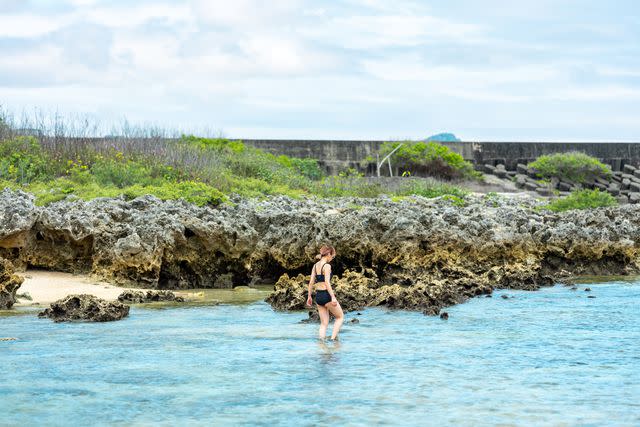
Sean Marc Lee
Wading on the Hengchun Peninsula.In the morning, we drove into the park with Gordon Chen, the thoughtful, soft-spoken doctoral student of Taiwanese history who would be our guide. He told us about the origin of the road we were on, the Central Cross-Island Highway, a massive Japanese imperialist project that thousands of largely Indigenous workers painstakingly cut through the mountains, several feet at a time, using dynamite. I had a hard time holding the facts in my head. They were being crowded out by the grandeur of the landscape looming around and above us.
We threaded our way between cliffs that reached so far up I lost sight of them, past sumptuous swaths of green and white marble accenting the rocks and the riverbed. We walked the Eternal Spring Shrine Trail, built to honor the workers who died building the highway, and visited the Swallow Grotto, where you can peer out at the rushing river from beneath the overhang of a cliff. At several points, we had to wear hard hats provided by the park to protect against possible falling rocks — as a “new” island, Taiwan’s geology is sometimes still figuring itself out.
With its misty cliffs and the occasional poetically situated pagoda, Taroko resembles the sort of classical scroll painting you might see at the National Palace Museum in Taipei. I had been chasing the perfect photo of the gorge ever since I arrived, but to capture even a piece of its massive scale I had to turn my iPhone upright, and still I was only getting half the scene. In the end, only a video would do, panning from eye level up and up to spectacular heights.
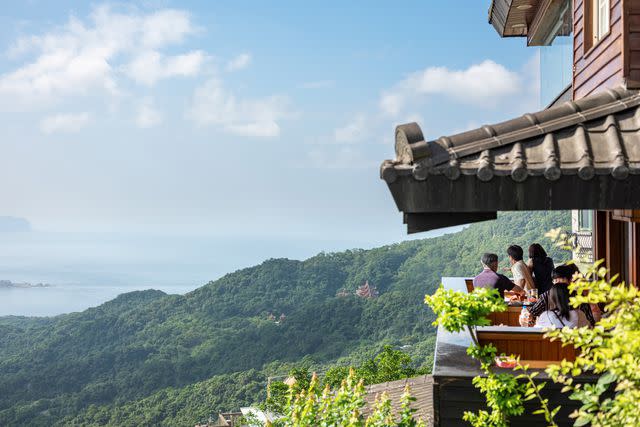
Sean Marc Lee
A teahouse in the mountains near Jiufen.For this reason, it was a relief to ascend to the higher echelons of the park to visit Buluowan, one of the few habitable flatlands within the gorge and a traditional hunting ground of the Truku tribe, members of which today run a hotel and educational site for visitors. We looked down from the panoptic perspective of the ultramodern Buluowan Suspension Bridge, the fourth iteration of a structure first built in 1914. The original earned itself the name “Resignation Bridge” — soldiers ordered to cross its rickety ropes would often quit instead.
More Trip Ideas: Travel + Leisure Readers' 5 Favorite Islands in Asia of 2023
The next morning, before heading to the airport, we visited the charming town of Xincheng, which has a beautiful beach called Qixingtan nestled between the mountains and cliffs. After the overpowering majesty of Taroko, all our landscape-soaked eyes wanted was to sit in the wood-paneled Long Gone Café to enjoy a proper latte and a bite of oolong-tea pudding. It felt like heaven to direct our senses inward, to flavors and textures, in the cozy embrace of a space constructed to the size and scale of the human body, rather than to that of giants.
After the literal and figurative highs of Taiwan’s verdant north and imposing central mountains, it was time to visit the Hengchun Peninsula, the southern reach of the island, and the remote tropical landscape of Kenting, where Taiwan’s first national park was designated in 1984. Our flight to Kaoxiong, Taiwan’s largest port city, took less than an hour, yet we noticed the difference in climate as soon as we stepped off the plane: the mountain mist and dramatic cloud sea had been swapped out for balmy late-spring heat and the kind of velvety sun that makes you want to fall asleep with a drink in your hand.

Sean Marc Lee
From left: An ice cream roll with peanut brittle shavings and cilantro at Jiufen's night market; a 400-year-old looking-glass tree in Kenting National Forest.Hsu joined us once more at the airport and drove us to the southernmost tip of the island, past fields of cacao and sun-sweetened pineapples, past small village shrines and fruit stands selling mangoes the approximate size and weight of a newborn infant. Pulling over to the side of the road, he bought us a heap of bell-shaped red fruit called wax apples — his favorite, he told us. The first bite was refreshingly tart, bright, and crunchy, with a gentle sweetness — a perfect snack for a hot, humid afternoon.
In the south of the island, we finally saw some horizontal lines in the landscape. The terrain seemed to relax as it slouched toward the sea, with only a few mountains in the background — which, after the week we’d had, felt like the topographical equivalent of a happy sigh. Driving into Kenting National Forest Recreation Area, where we passed tropical flowers intermingled with slender palms and the occasional stretch of ranchland dotted with cattle, I couldn’t help thinking of Malibu and Tulum before they became tourist hot spots: places where you could enjoy the simple extravagance of sunshine and the warm scent of grass.
Our hotel, Gloria Manor, was a former summer palace of Chiang Kai-shek, the general who fled to Taiwan from mainland China in 1950 and ruled the island for the next 25 years. Located right inside the park, it was renovated in an elegant mid-century style. We watched the sunset from our balcony, which overlooked the distant surf, with graceful Dajian Mountain punctuating the landscape like a period.
"Driving into Kenting National Forest Recreation Area, where we passed tropical flowers intermingled with slender palms and the occasional stretch of ranchland dotted with cattle, I couldn’t help thinking of Malibu and Tulum before they became tourist hot spots."
In the cool of the next morning, we headed into the nearby Hengchun Tropical Botanical Garden to learn more about the area’s ecological history. Kenting is a biodiversity hub, and its forests are riddled with limestone caves and uplifted coral reefs — we marveled at the surreal sight of coral on the top of a mountain, buried beneath a waterfall of roots. These tropical forests are the home of native monkeys and the shy spotted sika deer, as well as rare plants. One of these is the looking-glass tree, a Seussian marvel with roots that project far up out of the soil, forming sinuous, rippling buttress walls that can rise over three feet tall.
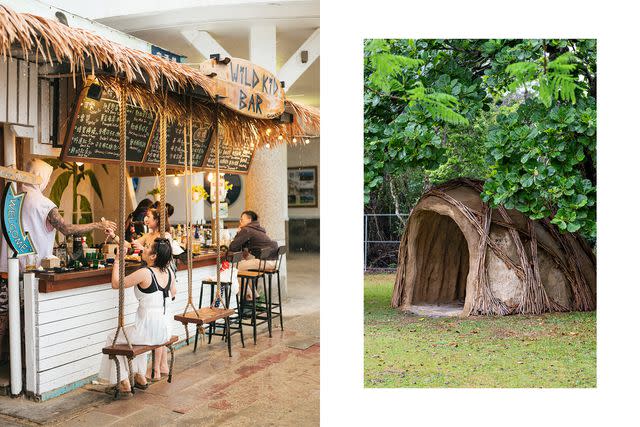
Sean Marc Lee
From left: The swinging chairs at the Wild Kids Bar, in Hengchun; a mud hut in Kenting National Forest.As we stopped to look at these surreal roots, an elderly female volunteer wearing a bright vest came over to talk to us. With our guide interpreting, she explained that this was a very special tree, one of the oldest in the forest, and that last year it became sick with a root disease. The community raised money for its treatment, and she visits it as much as she can to try to lift its spirits. She pressed something into my hand: one of the tree’s seeds, the size of an egg. “Maybe it’ll grow where you live,” she said to me, smiling.
After a quick snack at Ko Brunch, a café that serves scallion pancakes, radish cakes, and omelettes with adventurous fillings like tuna or pork chop, we drove out to Houbihou Beach and pulled on thick, floppy neoprene suits and water shoes for snorkeling in the calm waters. Beneath the waves teemed life of all kinds: bright parrotfish, neon-blue Taiwan reef cichlids, a humphead wrasse, even a four-foot sword-shaped silver one that eyed me nervously as I dog-paddled past. When I described it to our snorkeling instructor, a suntanned youth who was nursing a broken heart from a girlfriend who had split up with him during his year of mandatory military service, he nodded. “A needlefish,” he said. “They’re delicious — you can get one back in town, barbecued.”

Sean Marc Lee
Nan Wan Xiao Bai, the house dog at Wild Kid Bar, in Hengchun.We didn’t have the heart to eat the sad-eyed needlefish. Instead we strolled the streets of the nearby town of Hengchun and stopped at a cool surf bar on the beach — a sign over the door read WILD KIDS in handwritten capitals. Though the patio was full, there wasn’t a cell phone in sight, just people enjoying the loose, summery mood. In the open-air kitchen, the staff was doing Japanese-style robata grilling — little skewers of oysters or chicken skin or shishito peppers cooked over a charcoal flame and sprinkled with white pepper — as well as turning out all the french fries and mozzarella sticks a body yearns for after a long day surfing, paddling, and snorkeling under the hot sun. Alex grabbed a couple of ice-cold Taiwan beers, the crisp rice lager brewed by the government, and we leaned back in our chairs and watched the bar dog bark at passing mopeds.
Gazing out at the lights across the darkening bay, I realized that we had finally achieved that feeling of vacation bliss, the perfect ratio of tiredness and excitement, the perfect body temperature, the perfect breeze. We had reached the peak of Relaxation Mountain after a long and wild climb, and the view was spectacular.
How to Plan a Taiwan Trip
Taipei
Gaia Hotel: A contemporary hotel with in-room mineral baths drawn from sulphurous hot springs.
Mandarin Oriental, Taipei: This grand hotel in the financial district has impeccable service, a breakfast buffet that spans continents, and automated blackout curtains that help you sleep off your jet lag.
Din Tai Fung: Highlighting classic soup dumplings executed with masterful precision, this chain is also known for its elegant dessert dumpling, filled with sweet red bean paste.
National Palace Museum: This former palace of General Chiang Kai-Shek has one of the world’s greatest collections of Chinese art and artifacts, from ceramics and jade carvings to books and
scroll paintings.
Taipei 101: This landmark skyscraper has outdoor observation decks on the 91st and 101st floors, with views over the city and beyond.
Taroko
Liiko Hotel: A 34-room boutique hotel near the entrance to Taroko National Park that has fantastic views of the surrounding cliffs from every room as well as thoughtful nods to Indigenous culture in its décor and restaurant menu.
Long Gone Café: At this artsy, cozy spot within walking distance of the beach in Xincheng, browse a selection of art books while enjoying the café’s famous tea pudding.
Hengchun Peninsula
Gloria Manor: Nestled inside Kenting forest, this refined hotel, which has its own native-plant nursery, is an elegant perch from which to explore the area’s coral reefs, take an evening hike, or simply unwind with a sunset view.
Ko Brunch: This café opened late in 2022 just outside Kenting National Park. It serves excellent breakfasts in the local style. Try the shredded scallion pancake with white pepper and salt, topped with an egg.
Wild Kids Bar: A relaxed Hengchun beachside hangout serving tiki drinks, local beer, and made-to-order skewers of seafood barbecued on a charcoal robata grill.
How to Book
WildTaiwan: Whether you like vigorous outdoor excursions or want to uncover the best off-the-map food stalls, WildTaiwan crafts itineraries based on local knowledge and a sense of adventure. Co-founder Kendra Tombolato (kendra@wildtaiwantravel.com) can organize a weeklong journey to Taiwan’s wild places.
A version of this story first appeared in the October 2023 issue of Travel + Leisure under the headline "Made in Taiwan."
For more Travel & Leisure news, make sure to sign up for our newsletter!
Read the original article on Travel & Leisure.

